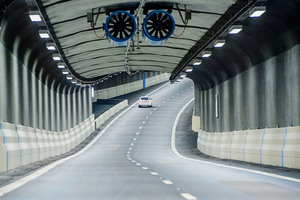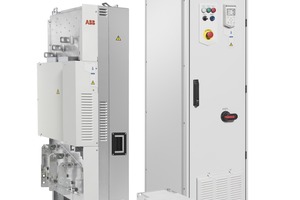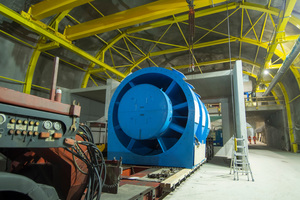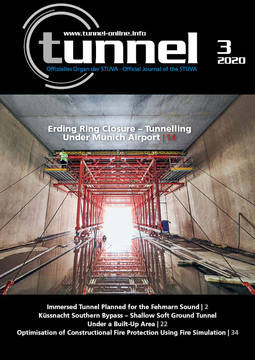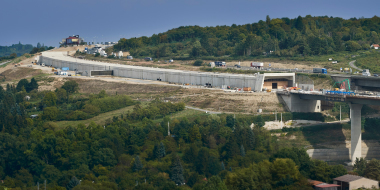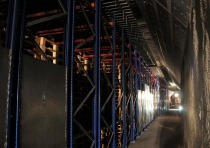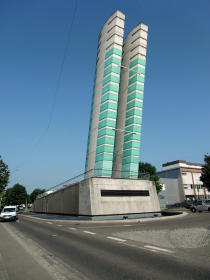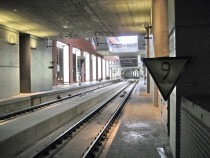Variable Frequency Drives for More Tunnel Safety and Energy Efficiency
Rail and road tunnels have to meet rigorous ventilation standards in terms of air quality and fire safety. Utilising variable frequency drives can help to ensure their maximum uptime and energy efficiency and reduce the risk for people in case of fire. That is why VFDs should be regarded a key element in the ventilation systems for the world’s most ambitious tunnel projects.
Energy Savings Through Variable Frequency Drives
Ventilation systems are a critical element in the safe operation of road and rail tunnels. As well as helping to maintain air quality and visibility they also play a vital role in fire safety management, both in containment and ensuring safe evacuation. This is where variable frequency drives (VFDs) play an increasingly important function. The drives sit between the electrical power supply and the fan motors, enabling their speed to be controlled precisely to meet the actual demand for ventilation – unlike fans that are either switched off or operate continuously at full speed.
With drives the speed of the fans can be adjusted by the tunnel’s overall control system to meet changing air flow needs during the day – typically triggered by sensors monitoring the levels of respirable dust, gases and other pollutants within the tunnel. This has a very significant impact on energy consumption.Very small speed changes can yield large energy savings – a speed reduction of 10% results in a 27% energy saving. Reducing fan speeds can also reduce noise levels – reducing the speed by only 20% will reduce sound pressure by more than 50%.
VFDs also play a critical safety role as in the event of a fire they can ramp up the fan speed rapidly. They also have the capability to change the direction of air flow to contain the spread of smoke and poisonous gases and create safe zones that enable the efficient evacuation of people from the tunnel. It is important to note that it is only axial fans and some jet fans that offer the capability to reverse the flow direction.
Fireman’s Override Mode
An important feature of many modern VFDs is the ‘fireman’s override’. This is an input that allows the fire service to take control of those VFDs controlling fans and turn them into smoke extraction units to maintain escape routes. In the event of a fire, this mode is usually triggered with a special key at the fireman’s control station. The override function forces the drive to a pre-defined set of running conditions stored in the override menu, including pre-set motor speeds or pre-set control locations. The VFD is programmed to ignore most of its warnings and alarms that would normally stop it if the application was at fault. This enables a ‘run at all costs’ mode of operation that ensures maximum availability during the emergency, potentially delivering precious extra minutes of breathable air for people escaping from a fire.
Regenerative VFDs Aid Grid Stability
With regenerative drive technology, when tunnel fans are shut down and ‘wind-milling’ it can be possible to utilize the air flow through them so that they effectively become generators. This produces energy that can be fed back into the local power network to reduce electricity costs and improve sustainability.
Furthermore, when a fast ramp down of fan speed is required, braking resistors are often used that dissipate energy as waste heat that adds to the heat burden of the tunnel. Drives that facilitate regenerative braking can eliminate the need for braking resistors and therefore reduce the heat output. As no external braking devices are needed, the drive installation is simplified, and the installation footprint is smaller.
Another important factor is that tunnels are often in remote locations, where the power grid can be ‘weak’, which means that its voltage becomes very sensitive to any variation in load, resulting in an unstable supply. With regenerative drive technology, it is possible to secure full load operation of the fans, even when there is a voltage sag on the power supply, either caused by a weak utility power supply or external influences such as a fire overheating the cables. This helps ensure full operation for a longer period of time than possible with traditional drives that cannot boost the voltage to the motor. When not delivering regenerated power to the grid, but operating the ventilation system, the active front end of the drive can be used to reduce the effect of harmonics on the transformer and thereby also helping to avoid overloading of the power supply.
Every Tunnel Requires a Bespoke Ventilation Scheme
The scope of tunnel ventilation projects can vary greatly. The ABB company has gained extensive experience with the use of variable frequency drives in complex projects. These include the Gotthard Base Tunnel, currently the longest railway tunnel in the world, and the Dr. Syama-Prasad-Mookerjee Tunnel, India‘s longest highway tunnel.
With the fans having an outer diameter of approximately 3.5 m, the Gotthard Base Tunnel has the largest and most powerful tunnel ventilation system in the world. It has an installed maximum power of 15.6 megawatt.
The system comprises 24 jet fans at the two tunnel portals and eight major supply and exhaust fans in the ventilation centres. The speed of the motors for the eight major fans are controlled by an ABB ACS1000 medium voltage (MV) drive, so that in each operating mode they only consume as much energy as is absolutely necessary.
The two ventilation centres form the ‘lungs’ of the entire system and are responsible for the exchange of air inside the tunnel. The supply air fans supply fresh air from the outside via long vertical shafts – that is regulated by shutters and is then distributed in the tunnel. The exhaust air is transported outwards through its own shaft via axial fans with an air speed of up to 300 km/h.
The whole system is designed as redundant for safety reasons. Because in addition to the regular exchange of air, the fans must primarily ensure enough fresh air in the emergency stations in the event of a fire and simultaneously suck the smoke through the long exhaust shafts. The control of the ventilation system is very important for the precise adjustment of the fans and the shutters in various scenarios. The master control system regulates approximately 50 scenarios – from normal and maintenance mode up to a full emergency.
The Dr. Syama Prasad Mookerjee Tunnel (formerly Chenani-Nashri Tunnel) was opened in 2017 to improve mobility and safety on India’s National Highway 44 that connects Kashmir, the country’s northern most state, to the rest of the country. With 9.2 km in length, making it the longest highway tunnel in India.
This two-lane road tunnel was the first in India and the sixth in the world, with a transverse ventilation system enabled by ABB drives and motors that uses separate air ducts to introduce fresh air inside the tunnel and remove the harmful air. The ventilation system uses low harmonic VFDs and motors installed at the North (Nashri) and South (Chenani) portals for air supply and exhaust. The VFDs are also equipped with inbuilt redundancy to ensure maximum uptime. The modern design of the tunnel includes a parallel escape tunnel apart from the main tube and special features such as an integrated traffic control system, fire detection and management, and wireless communication. The system’s safety software also includes an override control feature to mitigate any fire emergencies.

